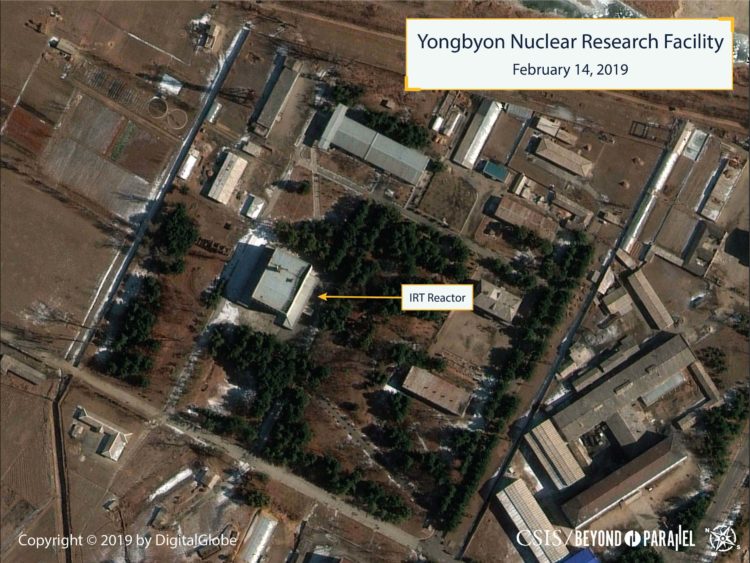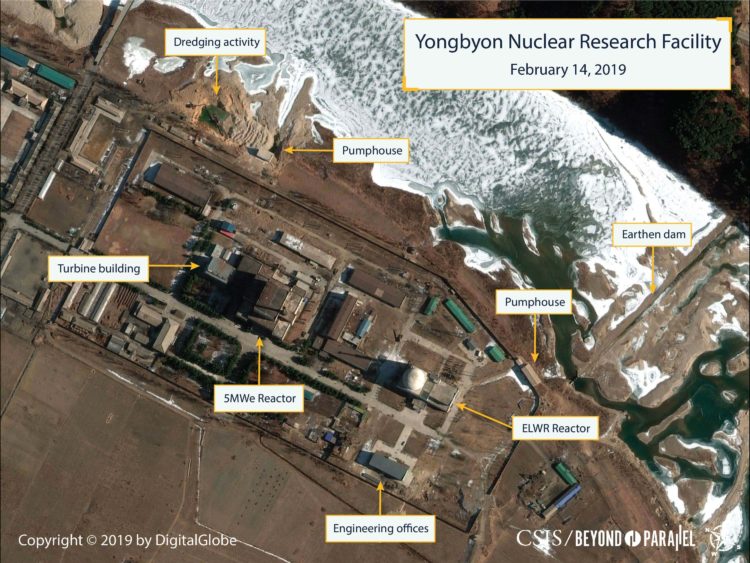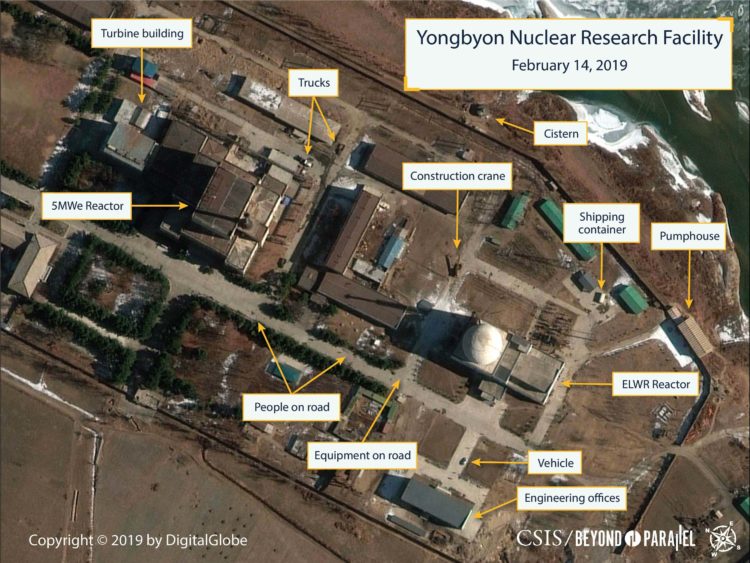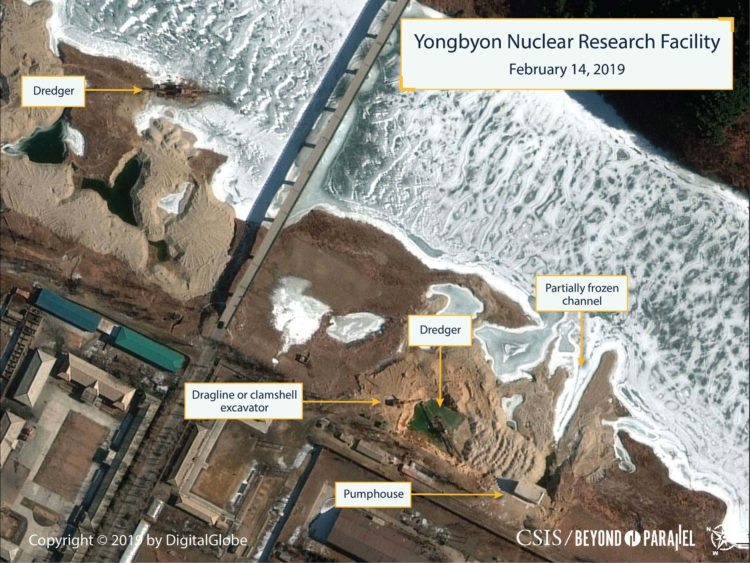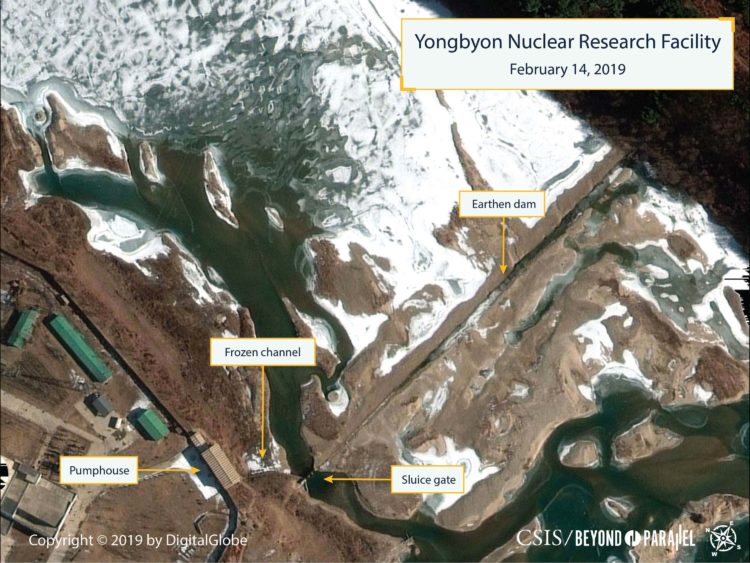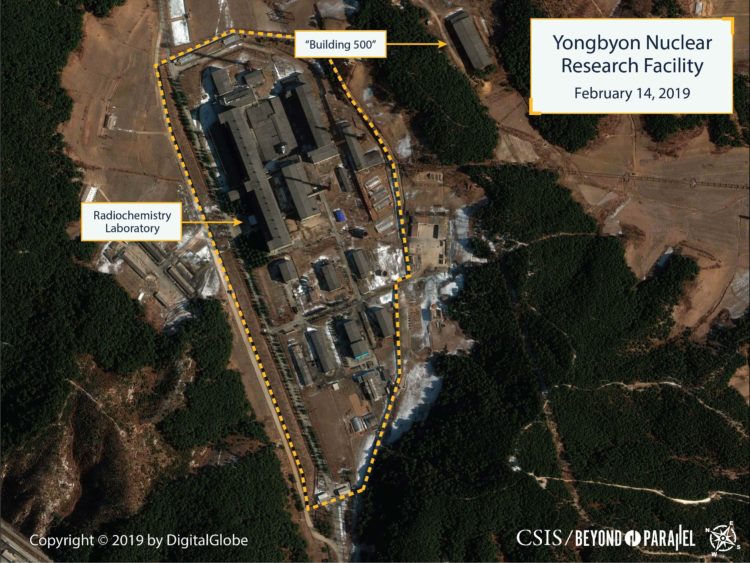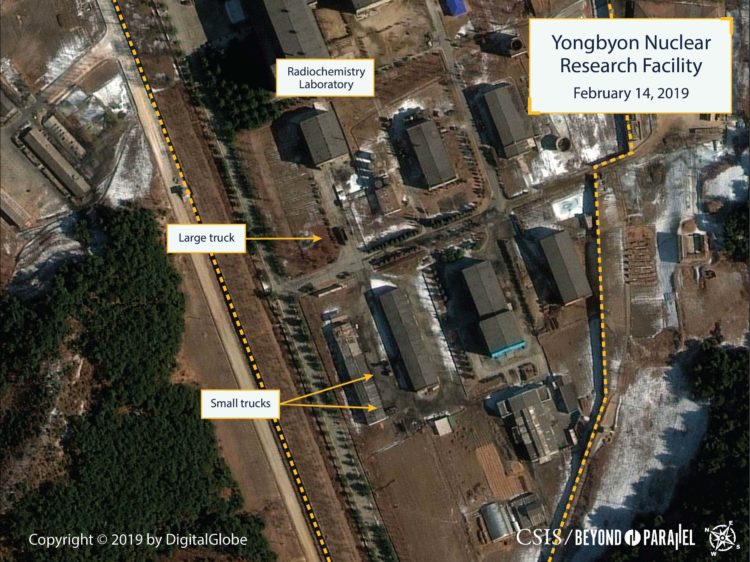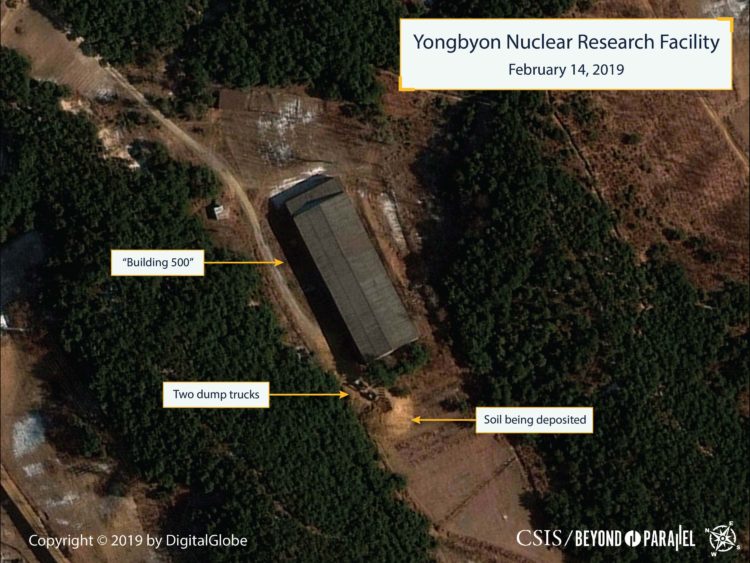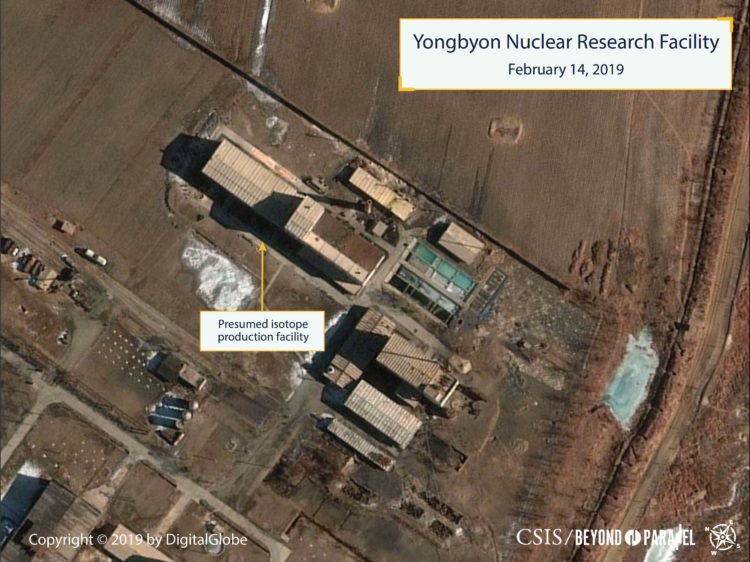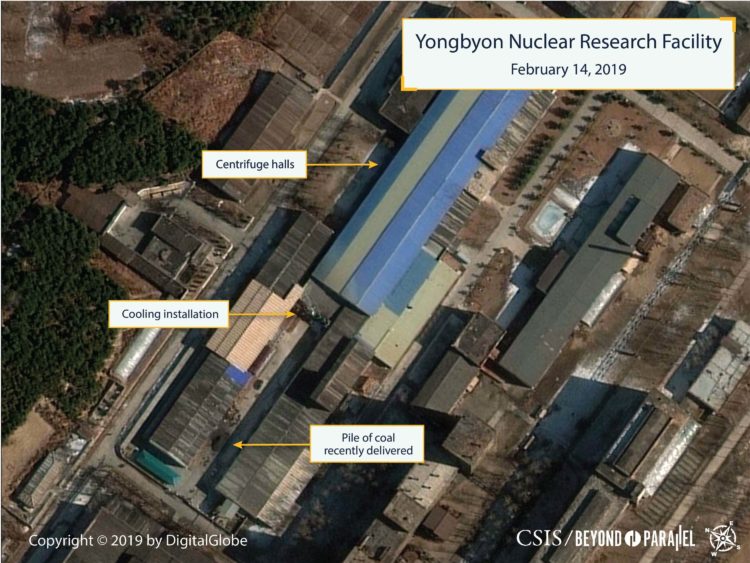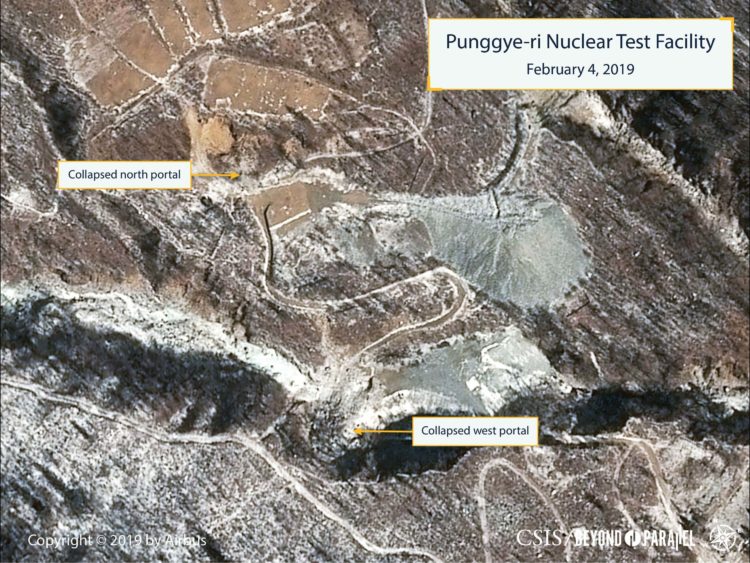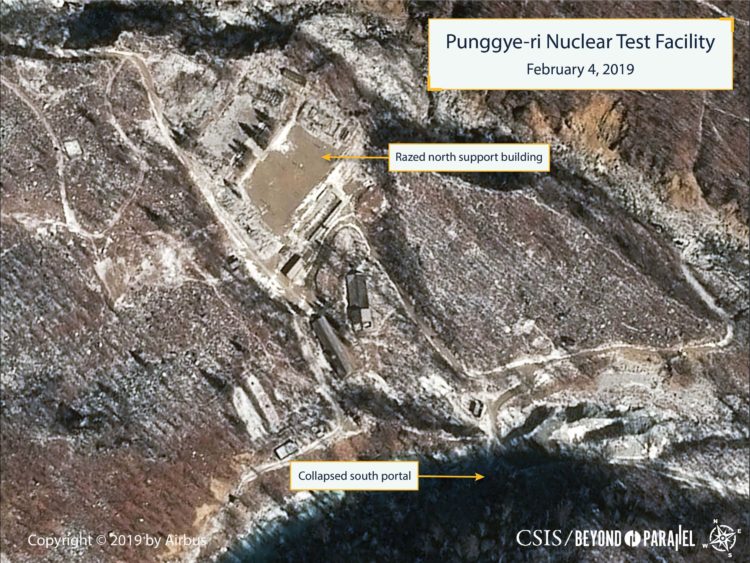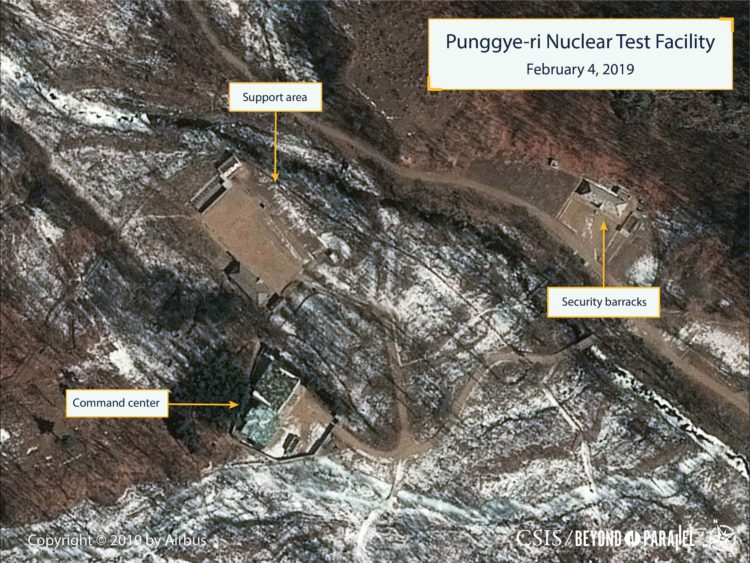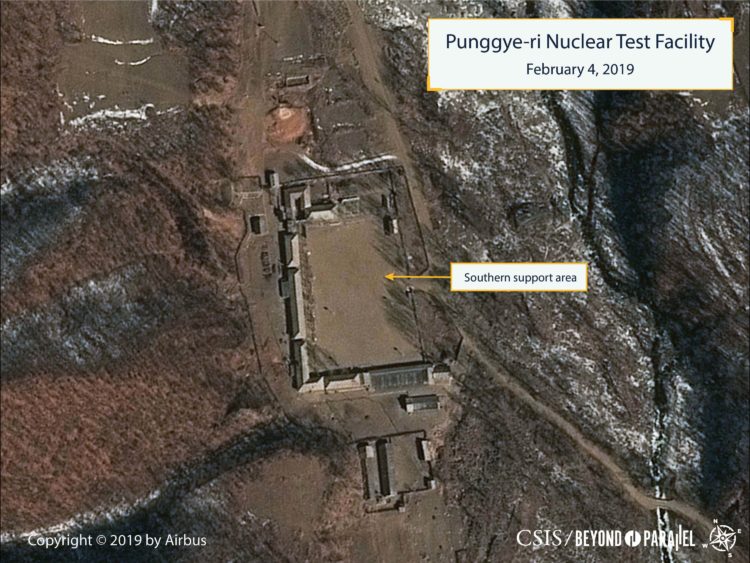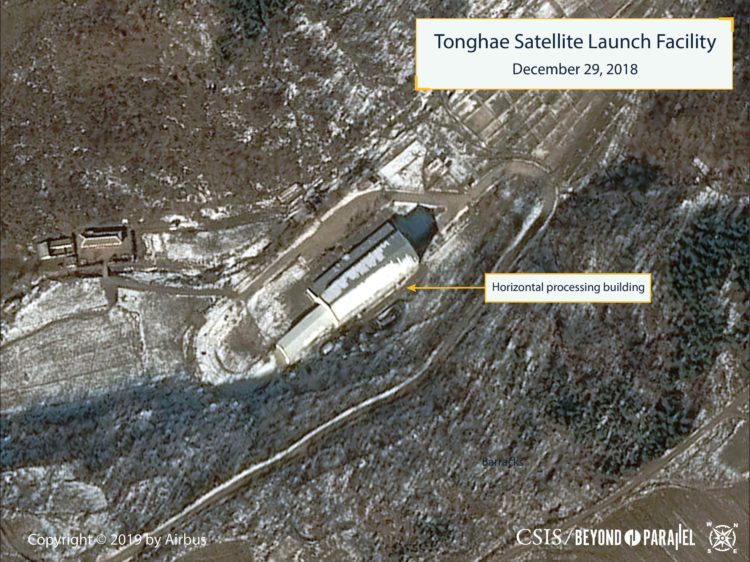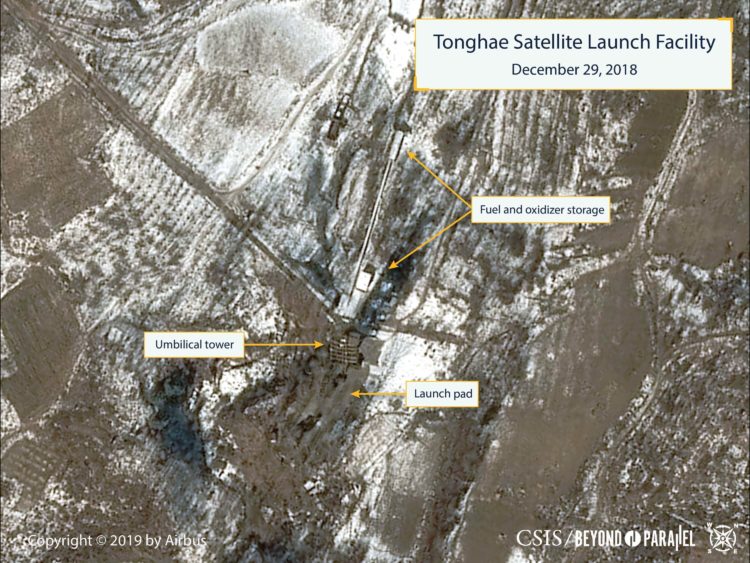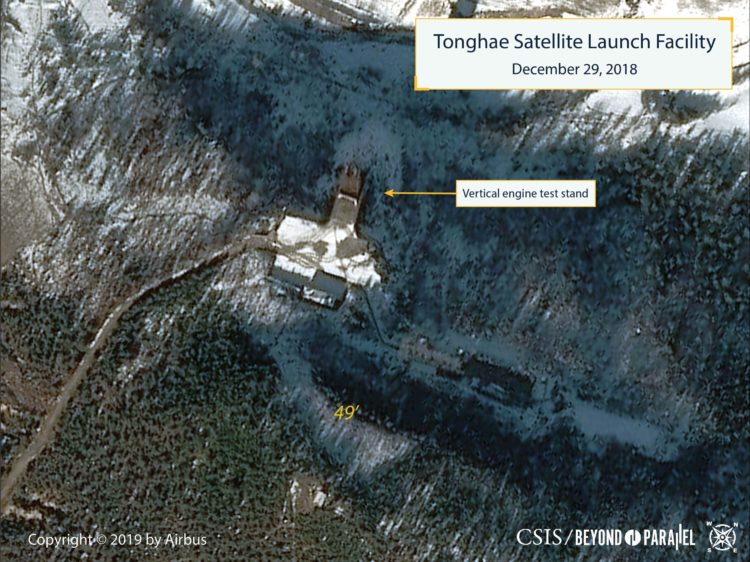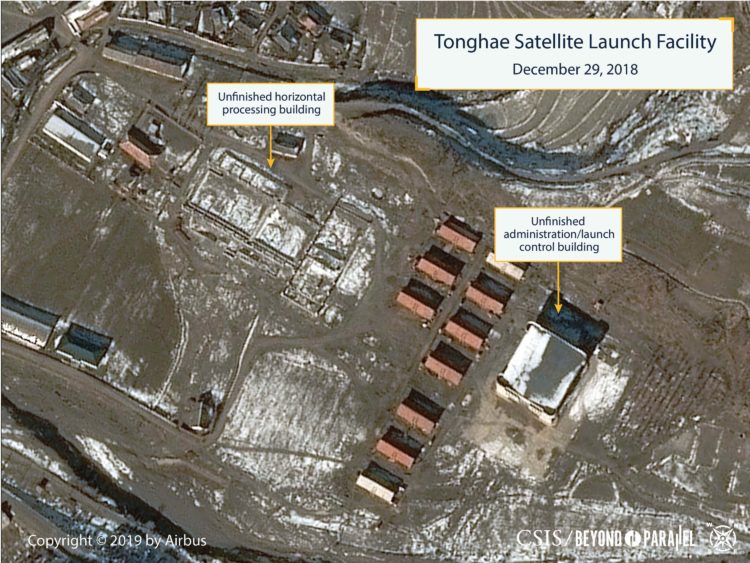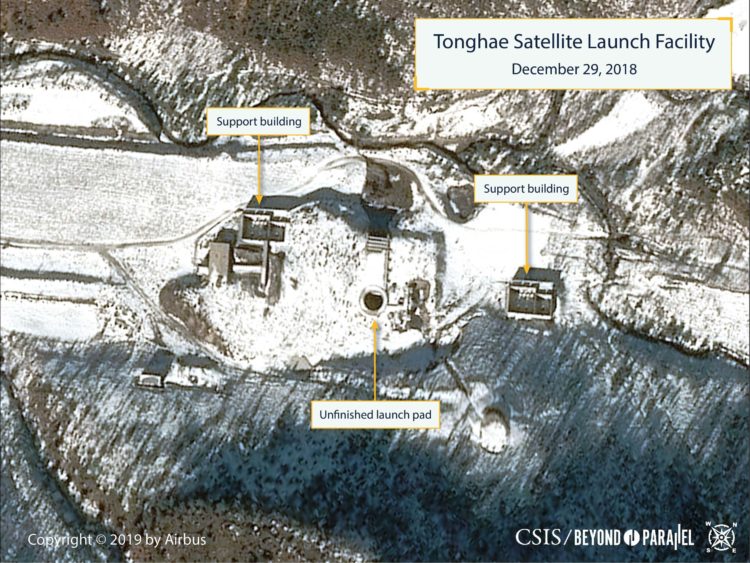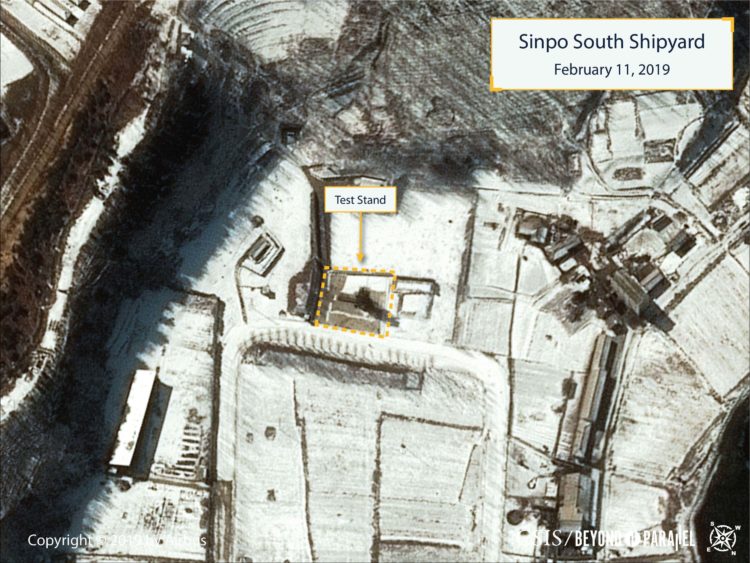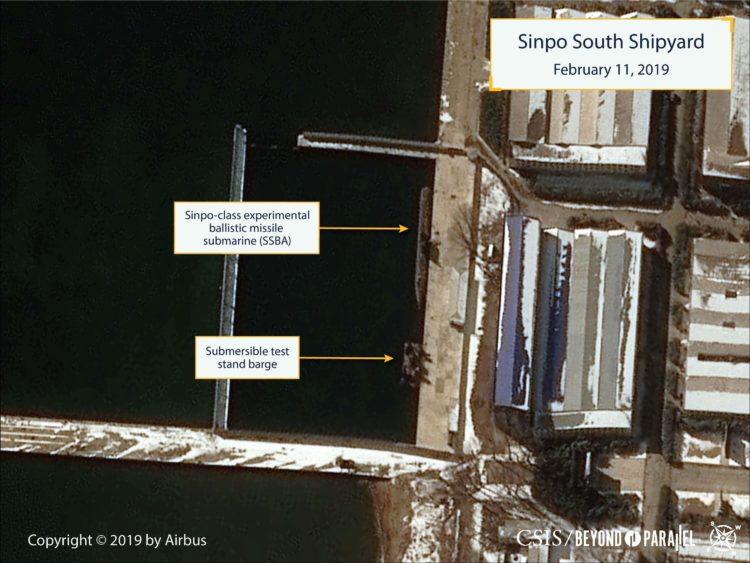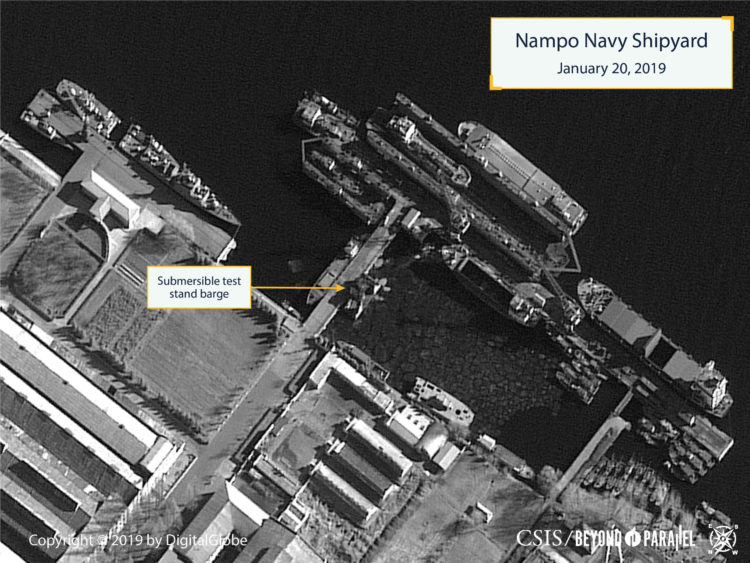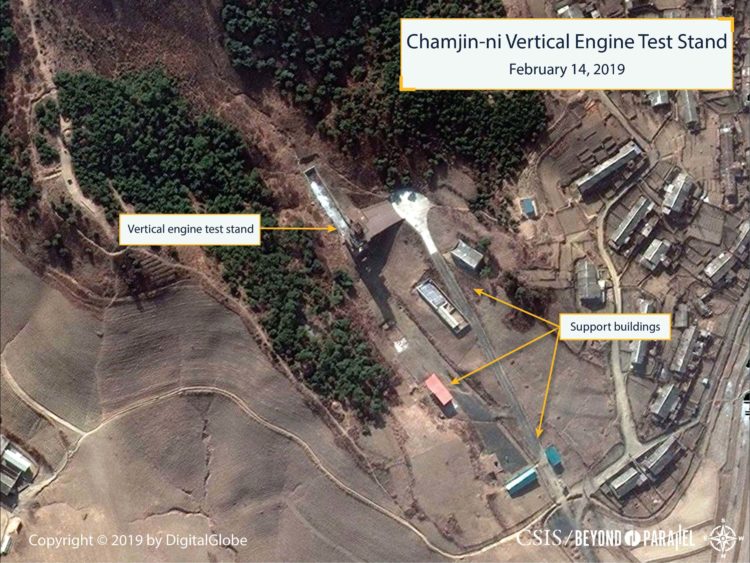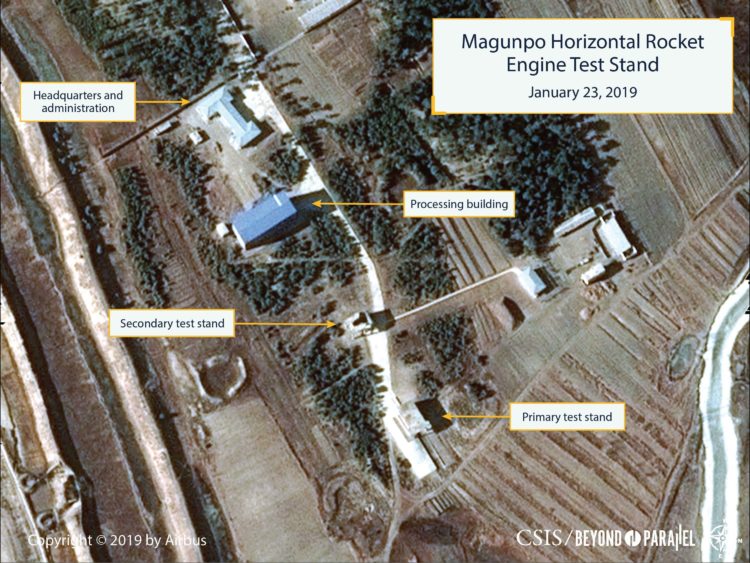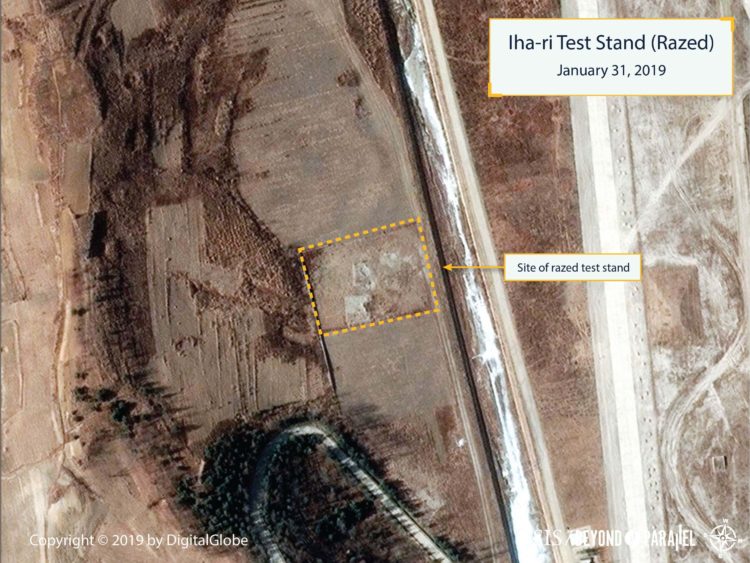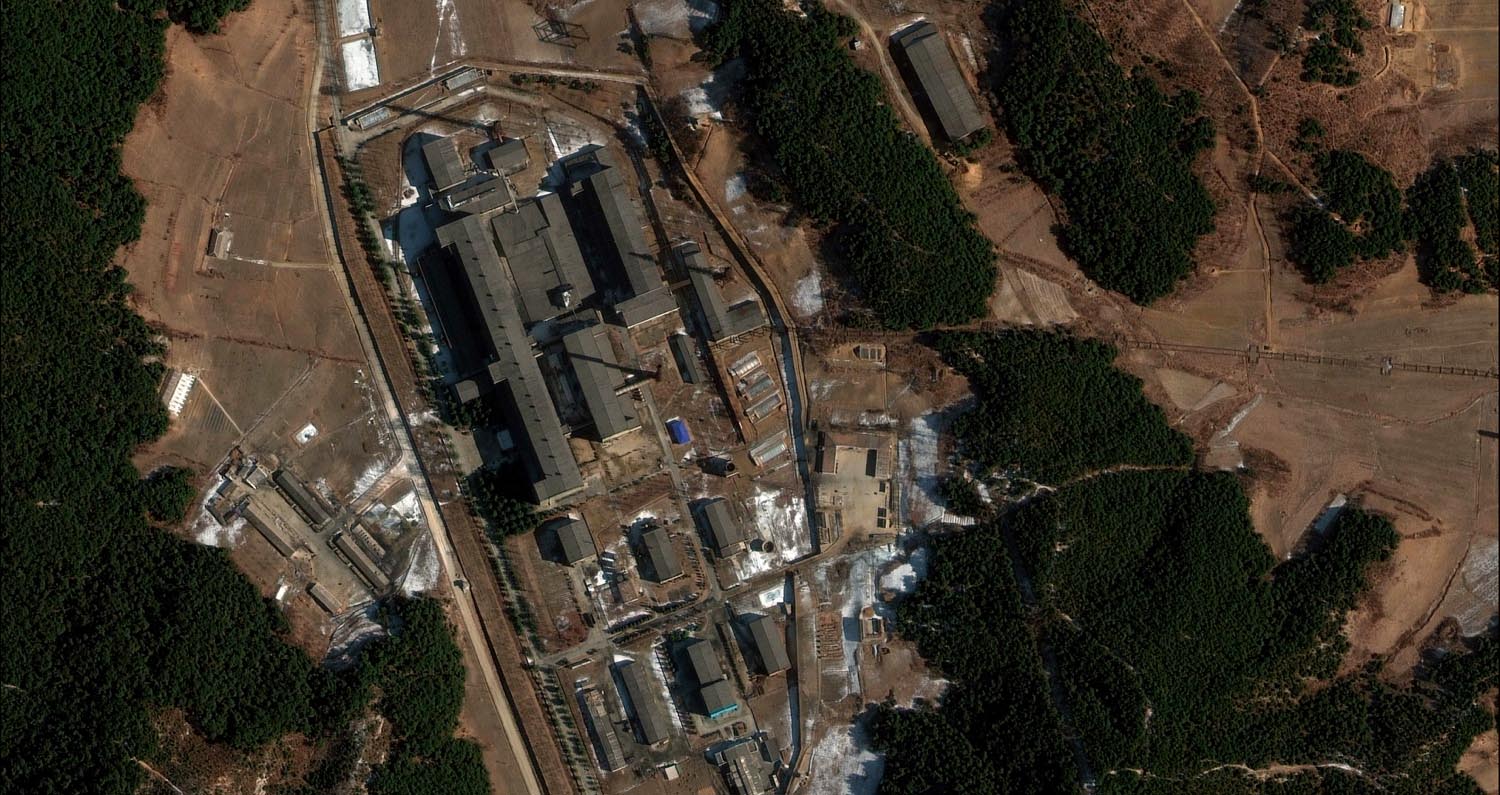
North Korean WMD Facilities Idle Pre-Trump-Kim Summit
Key Findings
- On the eve of the second summit meeting between President Trump and the North Korean leader, Kim Jong-un, a survey of North Korean missile and nuclear facilities indicates minor activity consistent with regular maintenance and upkeep of facilities at most major WMD sites.
- The absence of production activity at certain facilities suggests a wait-and-see mode, contingent on the results of the summit.
- Those facilities with little-to-no activity for over a year include the Tonghae (Musudan-ri) satellite launch facility, the Sinpo South Shipyard test stand, Chamjin-ni vertical engine test stand, Magunpo solid rocket motor test facility, and the Iha-ri test stand. These sites could provide a guide to which decommissioned facilities the North Korean leader may allow outside inspectors to visit as deliverables for the Hanoi summit.
- Recent imagery shows the Yongbyon nuclear facility being well-maintained but the 5-Megawatt Reactor (5MWe) and Experimental Light Water Reactor (ELWR) are also likely not in operation.
- Punggye-ri has witnessed some minor activity in the command center and the southern support areas but the activity is not indicative of a reopening of the facility.
- The Tonghae (Musudan-ni) launch facility is currently in caretaker status and has not witnessed any significant activity since the 2013-2014 period.
- There has been no activity at the Iha-ri Driver Training and Test Facility, built in 2016 to test solid-fueled ballistic missiles and the site of Kim Jong-un’s first observed launch of a Pukguksong-2 missile, since May 2018 when the facility test stand was razed.
- There has been no significant activity observed in satellite imagery since early-to-late 2017 for the remaining rocket engine test facilities and ballistic missile test stands at Sinpo, Nampo, Chamjin-ni and Magunpo.
As a follow-up to our recent report on the Sohae (Tongchang-ri) Satellite Launch Facility, Beyond Parallel undertook a brief satellite imagery survey of other major North Korean WMD facilities to determine if there were any new developments. The facilities reviewed for this report include:
- Yongbyon Nuclear Research Facility
- Punggye-ri Nuclear Test Facility
- Tonghae (Musudan-ni) Launch Facility
- Sinpo South Shipyard Test Stand
- Sinpo Class Ballistic Missile Submarine, Sinpo South Shipyard
- Sinpo South Shipyard Submersible Test Stand Barge
- Nampo Submersible Test Stand Barge
- Chamjin-ni Vertical Engine Test Stand
- Magunpo Solid Rocket Motor Test Facility
- Iha-ri Test Stand
Yongbyon Nuclear Research Center
While North Korea’s known nuclear research, development, and production infrastructure is dispersed throughout the nation, the Yongbyon Nuclear Research Center—established during the early 1960s—remains its central and most important facility. Among the more significant components of the facility are the: IRT reactor, 5MWe reactor, experimental light water reactor (ELWR), Radio Chemistry Laboratory (reprocessing), centrifuge halls (enrichment) and presumed isotope production facility.
Commercial satellite imagery collected between December 2018 and February 2019 clearly shows activity (e.g., movement of vehicles and construction equipment, dredging around the northern pumphouse for cooling water, movement of railroad cars, deliveries of coal, personnel walking on roads, minor excavation activity, etc.) throughout the facility including within the area of the 5MWe and ELWR reactors, Radio Chemistry Laboratory, centrifuge halls and “Building 500.” The reactors are likely not operating as the water channels for cooling water are partially frozen and no steam is observed being emitted from the turbine building as of mid-February.
Punggye-ri Nuclear Test Facility
While it is likely that North Korea had probably pre-surveyed the Punggye-ri site for use as a nuclear weapons testing ground as far back as the late-1980s, excavation of infrastructure and test tunnels likely began sometime during 1998-2000. Up until May 2018, Punggye-ri would remain North Korea’s sole nuclear test facility and the site for all six of its nuclear tests. Prior to the June 2018 Singapore Summit between Chairman Kim Jong-un and President Donald Trump, Kim issued a statement in April announcing a unilateral suspension of ballistic missile and nuclear tests. He also declared that the North would shut down the Punggye-ri nuclear test facility.
On May 24, 2018 foreign journalists observed the destruction of the portals to the four test tunnels and much of the northern support area at the facility. Satellite imagery collected since that time indicates that the portals remain closed and no significant activity has been observed at the northern support area. Minor activity, however, has been observed in the command center and southern support areas. None of this activity is suggestive of a reopening of the facility.
Tonghae (Musudan-ni) Launch Facility
The Tonghae Launch Facility is North Korea’s oldest ballistic missile and space launch facility with construction being observed in imagery as far back as 1984. By the mid-1990s the site had developed into a full-fledged launch facility with command, launch control, horizontal processing, launch pad with fuel and oxidizer storage and vertical engine test facilities. It remained North Korea’s primary launch and rocket engine test facility until the Sohae Launch Facility became available.
It was from this facility that North Korea conducted numerous ballistic missile tests, the 1998 Paektusan (later renamed the Unha 1) SLV launch and the subsequent 2009 Unha 2 SLV launch. Since that time no additional launches have been conducted from the Tonghae facility.
During 2011, a modernization program was begun at the Tonghae facility. This, however, was suspended during 2013-2014 and the facility placed in caretaker status. Commercial satellite imagery collected since that time indicates that the facility still remains in caretaker status today.
Sinpo South Shipyard Test Stand
A small missile test stand has been present at the Sinpo South Shipyard since at least mid-2012. During the following year it was replaced by the current test stand. This larger stand has been used for launching sub-scale submarine-launched ballistic missiles (SLBM), testing ejection systems for SLBMs and conducting ejection tests of Pukguksong-1 SLBM prototypes. No significant activity has been observed at the test stand since November 2017. A counterpart test stand was built at the Iha-ri Driver Training and Test Facility during early 2017 but was razed during May 2018 (see below).
Sinpo Class Ballistic Missile Submarine, Sinpo South Shipyard
North Korea’s sole experimental ballistic missile submarine (SSBA) was first identified in commercial satellite imagery at the Sin’o South Shipyard during July 2014. Since that time, it has conducted several short sea voyages and conducted several ejection and test launches of the Pukguksong-1 submarine-launched ballistic missile (SLBM). The last test being during August 2016. Since that time the Sinpo Class SSBA has apparently remained docked within the secure boat basin at the Sinpo South Shipyard.
Sinpo South Shipyard Submersible Test Stand Barge
A submersible test stand barge is a critical component in any submarine-launched ballistic missile (SLBM) test and development program. North Korea’s first submersible test stand barge was first identified in satellite imagery during October 2014. The test stand was used to conduct several early tests of the Pukguksong-1 SLBM, however, since early 2017 it has remained docked at its current position within the secure boat basin at the Sinpo South Shipyard.
Nampo Submersible Test Stand Barge
North Korea’s second submersible test stand barge was first observed on the repair ways at the Nampo Navy Shipyard during April 2017. During November 2017, it was moved from the repair ways to the shipyard’s fitting-out dock. Sometime around September 2018 it was moved from here to an adjacent secured boast basin. It is not known to have been used for any testing and has remained docked in the secured boast basin since then.
Chamjin-ni Vertical Engine Test Stand
The Chamjin-ni vertical engine test stand is North Korea’s oldest known vertical engine test stand having been established during the mid-1980s. It is known to have been involved in all of the North’s early ballistic missile and space launch vehicles (SLV) programs. The last reported test at this location occurred during March 2016 when Kim Jong-un attended a test of the nose cone for what appears to have been reentry vehicle. Imagery from 2000 to present shows that it has remained relatively unchanged until late 2016 – early 2017 when a minor upgrade to the facility was undertaken. No activity has been observed in satellite imagery at the facility since that time.
Magunpo Solid Rocket Motor Test Facility
Built during 2013-2014, the Magunpo Rocket Engine Test Facility is North Korea’s primary large solid-propellant rocket engine test facility. During March 2016 Kim Jong-un observed the test of a large solid-propellant rocket engine at the facility (there is also a secondary smaller test stand). While there were reports of an additional test during late-2017, no conclusive evidence is observed in imagery from that period. Since that time no significant activity has been observed at the facility.
Iha-ri Test Stand
The test stand at the Iha-ri Driver Training and Test Facility was constructed during early 2016 to assist with the development of the canister and ejection systems for the solid-propellant Pukguksong-2 medium-range ballistic missile (MRBM). It also served as a test site for other new cannister launched ballistic missiles and the Pukguksong-2’s new tracked transporter-erector-launcher (TEL). The Pukguksong-2 is the land-based version of the Pukguksong-1 SLBM. The Iha-ri stand is viewed as a counterpart to that at the Sinpo South Shipyard. Kim Jong-un observed the first Pukguksong-2 test launch, from the new TEL, on February 13, 2017 at the Iha-ri facility. Following Kim Jong-un’s April 2018 statement announcing a unilateral suspension of ballistic missile and nuclear tests, the Iha-ri test stand was razed during May 2018. No activity has been observed in satellite imagery since that time indicating the construction of a replacement test stand at the Iha-ri facility.

